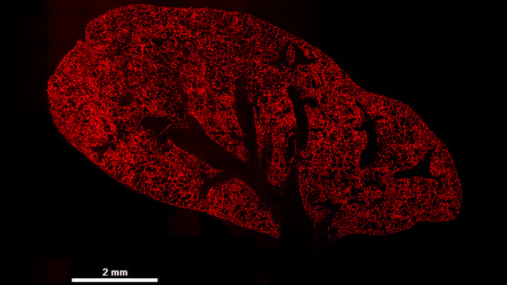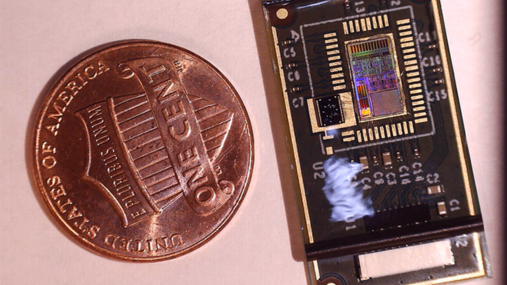In 2024, the NIBIB communications team covered a wide variety of advances supported by the institute, from biomedical imaging to engineered nanomaterials to AI applications in health care. We present here a sample of some of the most-read articles written this year. We look forward to sharing more exciting science news about NIBIB-supported research in 2025!
Health Applications of Artificial Intelligence
A collaborative NIH-funded team is using AI to mine routine computed tomography (CT) scans of the chest to predict mortality. Their research identified a collection of cardiac factors that were predictive of death in a large group of patients, potentially setting the stage for improved cardiac screening which could identify high-risk patients.
A team of NIBIB-funded researchers recently developed an AI platform that can analyze 3D pathology images to predict disease outcomes. Their method had improved performance in predicting prostate cancer outcomes when compared with traditional pathology approaches, such as analysis by expert pathologists using 2D images.
To better understand the fairness of medical imaging AI, researchers trained over 3,000 models spanning multiple model configurations, algorithms, and clinical tasks. Their analysis of these models reinforced some previous findings about bias in AI algorithms and uncovered new insights about deployment of models in diverse settings.
Engineering Nanomedicine
Researchers have developed sugar-coated gold nanoparticles to both image and destroy biofilms. In this study, they used the nanoparticles on the teeth and wounded skin of rats and mice, eliminating biofilms in as little as one minute and outperforming common antimicrobials.
NIBIB-funded researchers have established an RNA-based method that drives cells in the body to produce therapeutic proteins and secrete them into the bloodstream. This approach could extend the lifespan of drugs in the body, reducing the burden on patients who have to take frequent doses of medication.
Through rational engineering of lipid nanoparticles, researchers developed a way to effectively target specific organs in the body to precisely deliver therapeutic cargo, including gene-editing molecules. Their technique resulted in durable gene editing in mouse lungs for nearly two years and showed promise in correcting a mutation present in a currently untreatable form of cystic fibrosis in several models of the disease.
Biomedical Imaging Advances
The qualities of flowing blood, or hemodynamics, hold important insights into vascular diseases, but technological limitations have largely kept measurements of these properties out of reach in the clinic. Now, there may be a potential solution on the horizon.
A multidisciplinary group of NIH-funded scientists have successfully captured real-time, high-resolution images of the developing mouse placenta during the course of pregnancy. Their technique, which combines a surgically implanted window with a next-generation imaging system, provides key insight into placental development under both healthy and pathological conditions.
To provide better diagnosis and treatment of chronic liver diseases, researchers are working to use non-invasive MRI to detect and quantify liver fibrosis throughout the entire organ, which would enable earlier detection and the ability to monitor disease progression as well as the effects of treatment over time.
Diagnostic Technologies
To date, nine medical device developers participating in the RADx® Tech Independent Test Assessment Program have received emergency use authorization for at-home and point-of-care test products that simultaneously detect COVID-19 and flu A/B.
A collaborative team of NIH-funded researchers is developing a way to obtain DNA shed from brain tumors using focused ultrasound. Their first-in-human study could be an important step towards improving the way brain tumors are diagnosed.
Early detection of respiratory diseases is critical for treatment. Researchers at the Georgia Institute of Technology have developed a wearable lung patch which, in a pilot study, detected wheezing, a common indicator of asthma and chronic obstructive pulmonary disease (COPD).
Meet a Scientist
In recognition of International Women’s Day (March 8), this profile featured Rebecca Richards-Kortum, Ph.D., a longtime bioengineer in academia who has contributed globally to improving women's health.
Parinaz Fathi, Ph.D., is an early career researcher at NIBIB, leading an intramural research unit in the institute’s Section on Immunoengineering. This profile highlights her scientific achievements as well as her hobbies, including scientific art.
NIBIB bioengineer Kaitlyn Sadtler has flourished as a leader of many impactful, interdisciplinary studies. For her role in shaping the future of medical research, TIME magazine has named Kaitlyn Sadtler to the TIME100 Next 2024 List.
Events and Outreach
This summer, 50 congressional staff visited NIH to learn about cutting-edge technologies that could become transformative medical applications in the future and participated in five hands-on demonstrations given by NIBIB-funded grantees and intramural researchers.
This fall, NIBIB spearheaded an event to facilitate meaningful research connections by introducing extramural investigators to NIH resources and engineers, scientists, and clinicians from the Intramural Research Program (IRP).
NIBIB held a challenge that solicited biomedical engineering learning materials geared toward middle school students. This year, the winning lesson plans were finalized and made freely available.



















